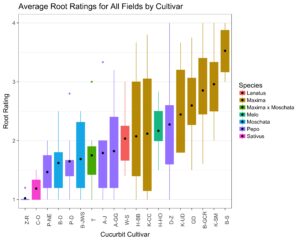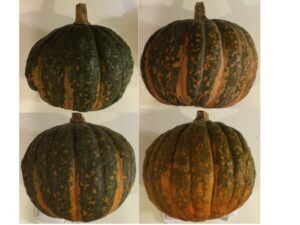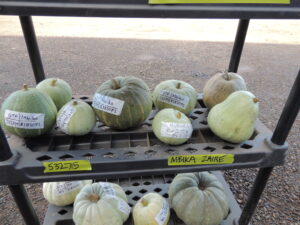Final report for SW15-021
Project Information
Winter squash is grown in the Willamette Valley of Oregon for fresh market sales and as a processing crop for pie filling and confectionary seed. However, a soilborne disease is reducing yield and quality of both fresh market and processing squash. The overarching goal of this project is to increase the economically viable production of winter squash and confectionary seed. This project will work towards that goal by diagnosing squash wilt and root and crown rot, identifying resistant/tolerant varieties, and evaluating the efficacy of crop rotation, fungicides, and other management strategies.
This project will engage farmer participants and other farmers throughout the course of the project. Field trials will be conducted on participating farm fields. Field tours will be conducted each fall. Project findings will be presented at the N. Willamette Hort Society Vegetable and Organic Days, the Oregon Processed Vegetable Annual Meeting, and the OSU Small Farms Conference. Farmers and buyers will interact with whole and cut squash at interactive conference booths each winter.
At least 200 farmers have learned about this disease complex through project outreach activities. These farmers have learned about the symptoms, pathogens and the effect on squash yield. They are also learning to diagnose and scout for the disease. Some farmers grew Tetsukabuto, a resistant variety, in 2016. They liked the field, storage, and culinary performance of this less susceptible variety. However, most cucurbit species and varieties have little resistance. Cucurbita maxima germplasm with resistance was identified for use in breeding resistant germplasm with market potential. Rotation (out of all cucurbits) will be an important strategy for the management of this disease, as is true for most soilborne disease caused by pathogens of limited host range. As farmers learn about the disease and its yield implications, and scout for it on their farms, they are considering how to implement longer cucurbit rotations. Some project farmers planted 2016 squash crops on ground with no history of cucurbit production. Fungicides will not be an effective management strategy for this soilborne disease complex.
Objective 1) Engage project farmers in project development, delivery, evaluation, and outreach
Objective 2) Identify causal agents of squash wilt and root and crown rot
Objective 3: Identify squash cultivars with resistance or tolerance to squash root and crown rot/wilt, as well as good yield and long shelf life
Objective 4: Evaluate the efficacy of crop rotation
Objective 5: Evaluate the efficacy of available fungicides
Cooperators
Research
Objective 1) Engage farmers in project development, delivery, evaluation, and outreach (see Outreach below)
On-farm research trials, field days, presentations at winter grower meetings, sensory evaluations (tastings) and informational handouts were used to engage farmers.
Objective 2) Identify causal agents of squash wilt and root and crown rot
Sixty-four Golden Delicious fields were surveyed in the 2014-2016 seasons to attempt to characterize the community of fungi associated with roots and crowns of diseased and healthy squash. Fungal isolates from sampled plants were subjected to ITS and EF1 sequencing to identify to species. Isolated fungal communities were analyzed with multivariate statistical techniques in PC-ORD software (multi-response permutation, indicator species analysis and nonmetric multidimensional scaling).
Objective 3: Identify squash cultivars with resistance or tolerance to squash root and crown rot/wilt, as well as good yield and long shelf life
Research station and on-farm variety/host range trials were conducted in 2015 (and are being repeated in 2017) in fields with a known history of the soilborne disease complex. Sixteen cultivars representing three winter squash as well as cucumber, melon and watermelon species were grown in replicated complete block trials in three locations. Plants were harvested and root, crown and vascular tissue was evaluated for disease symptom severity.
In 2016, thirty four accessions from the USDA GRIN C. maxima germplasm collection were assessed for disease resistance in a replicated trial conducted on farm field with high inoculum potential. Tetuskabuto was included as a resistant control. Golden Delicious and Uncle David were included as susceptible controls. The goal of the experiment was to identify germplasm with resistance for future breeding efforts.
Objective 4: Evaluate the efficacy of crop rotation
A replicated 2016 irrigation trial planted to Golden Delicious compared disease severity on a split field; half had a history of intensive (3 out of 4 years) squash production and the other half had a history of extensive (1 out of 4 years) squash production. Severity was assessed on a 1-4 scale for root rot, crown rot, and vascular discoloration and a mean severity rating was calculated.
Forty-nine farm Golden Delicious fields were evaluated for disease severity just before harvest in 2016. Twenty plants were collected per 25 acres in each field (fields ranged in size from 25 to 325 acres) and symptom severity was evaluated for root rot, crown rot, and vascular discoloration.
Objective 5: Evaluate the efficacy of available fungicides
Two fungicide (prothioconazole) trials were conducted on farm fields planted to Golden Delicious or other processing squash with a known history of the soilborne disease complex.
Objective 1) Engage farmers in project development, delivery, evaluation, and outreach
See Outreach and Educational Activities below.
Objective 2) Identify causal agents of squash wilt and root and crown rot
Three species were consistently associated with disease symptoms: Fusarium oxysporum, F. solani and Plectosphaerella cucumerina. These species were also identified as indicator species of crop rotation history, cucurbit species sampled, and plant tissue sampled. Ordinations of these results showed the fungal community structure associated with winter squash and highlighted the influence of these three fungi on diseased plants. Results of community analyses provided insight into potential causal agents and will allow for more focused pathogenicity trials to further understand this problem.
Objective 3: Identify squash cultivars with resistance or tolerance to squash root and crown rot/wilt, as well as good yield and long shelf life
Host range trial: Winter squash varieties of all three species of winter squash (Cucurbita. maxima, C. moschata, and C. pepo), as well as cucumbers (Cucumis sativus), melons (Cucumis melo) and watermelon (Citrullus lanatus), are susceptible to this disease complex. However, some are more susceptible than others. Summer squash and zucchini (both Cucurbita pepo) are not very susceptible.

Tetsukabuto, a commercial variety that is generated by a C. maxima x C. moschata cross, was much less susceptible than all other winter squash cultivars; this variety is also very high yielding. Tetsukabuto was also resistant to storage rots and very long storing (even under barn-type storage conditions) in storage trials and was rated highly by chefs and consumers in sensory evaluations.

Resistant germplasm for future breeding efforts: Tetsukabuto as well as 12 GRIN accessions were shown to have resistance to the soilborne disease complex and can be used in future breeding programs.

Objective 4: Evaluate the efficacy of crop rotation
Deficit irrigation trial: Disease severity was lower (2.7 compared to 3.1, out of a maximum of 4) and yield was 22% higher on the field with a history of extensive winter squash production than on the field with a history of intensive (3 out of 4 years in winter squash) squash production.
Field survey: Mean disease severity (across root, crown and vascular tissues) was mild in 49% of the fields, moderate in 33% of the fields, and severe in 18% of the fields. Rotation histories will be collected for these fields and rotation history will be related to disease severity. This data will reveal if there is a relationship between squash production intensity and yield and if specific rotation crops are related to disease severity.
Objective 5: Evaluate the efficacy of available fungicides
Fungicide (prothioconazole) trial: This fungicide was not effective in suppressing disease or increasing yield.
Impacts
This disease complex has never been described previously. At least 200 farmers have learned about this disease complex through project outreach activities. These farmers have learned about the symptoms, pathogens and the effect on squash yield. They are also learning to diagnose and scout for the disease.
Some farmers grew Tetsukabuto in 2016. They liked the field, storage, and culinary performance of this less susceptible variety. However, few cucurbit species and varieties have resistance. Cucurbita maxima germplasm with resistance was identified for use in breeding resistant germplasm with market potential.
Rotation (out of all cucurbits) will be an important strategy for the management of this disease, as is true for most soilborne disease caused by pathogens of limited host range. As farmers learn about the disease and its yield implications, and scout for it on their farms, they are considering how to implement longer cucurbit rotations. Some project farmers planted 2016 squash crops on ground with no history of cucurbit production.
Fungicides will not be an effective management strategy for this soilborne disease complex.
Research Outcomes
Education and Outreach
Participation Summary:
Examples from 2016 (1 of 3 years - see annual reports for details from 2014 and 2015):
- Presentation on symptoms of soilborne disease complex and yield and quality of Tetsukabuto, a winter squash variety resistant to this disease. Sensory evaluation (tasting) of Tetsukabuto and other long storing winter squash varieties. North Willamette Hort Society Organic Day. Jan 12 2016 80 attendees
- Squash table (squash display, information on variety trials, soilborne and storage diseases), North Willamette Hort Society Vegetable Day. Jan 13 2016. 50 attendees.
- Squash presentations and field tour, Organic Seed Conference field day. February 4, 2016. Squash display, 4 poster presentations (squash sensory evaluation, soilborne disease complex diagnosis, variety trialing, squash storage). 150 attendees.
- Small farm training workshop. Squash production and storage presentation. Feb 10 2016. 15 attendees.
- Presentation on diagnosis, fungicide efficacy, and host range of soilborne disease complex of cucurbits. Processing Squash Management Field Day. July 13, 2016. 50 attendees.
- Overview of the winter squash project and 2016 field experiments. WSARE field tour. July 14 2016. 25 attendees.
- Dryland squash experiment field tour. Aug 9 2016. 25 attendees.
- Squash project field day (NOVIC field day). 4 poster presentations (squash sensory evaluation, soilborne disease complex diagnosis, variety trialing, squash storage). Sept 6 2016.
- Deficit irrigation in Golden Delicious presentation. Processed Vegetable Field Day. OSU Vegetable Farm. Sept 19 2016.
- Winter squash booth. Variety Showcase. Portland, OR. Oct 3 2016. 250 attendees.
- Organic processed vegetable rotation crop and rotation planning workshop. Brief presentation on soilborne disease problem in processing squash and possible rotation scenarios. Dec 1 2016. 25 attendees.
Education and Outreach Outcomes
The soilborne disease of winter squash is caused by at least 3 if not 4 pathogens, and the relative importance of those pathogens in causing disease likely varies depending on the cropping history of the field; of this reason, more diagnostic work is required. While squash cropping intensity is related to disease severity, more work is required to better understand the relative susceptibility of squash species and cultivars. In addition, it is possible that at least one of the pathogens causes disease on non-cucurbit crops.
- diagnosis
- crop rotation
- resistant varieties
- fungicides
- deficit irrigation and dryland production